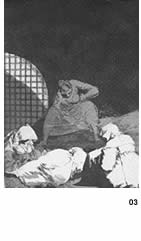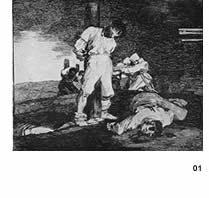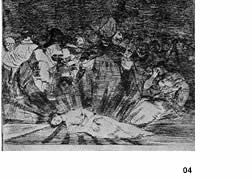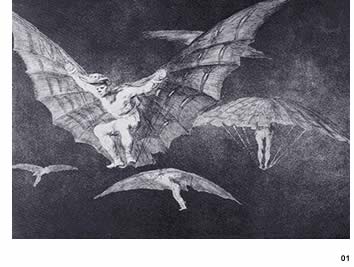
















 |
 |
 |
 |
|||||||||||||
 |
 |
 |
 |
 |
 |
|||||||||||
 |
 |
 |
 |
|||||||||||||
 |
 |
 |
||||||||||||||
| Francisco
Goya (1746 - 1828) the Print Sequences
Goya deserves
particular study within a course dedicated to the sequential. He has a
remarkable ability to
REVERSE CHRONOLOGY.
1799 Caprichos
first edition |
CAPRICHOS 01. Que viene el Coco (The Bogeyman is Coming) etching and aquatint, 215 x 150 215 x 150mm. "Que bieno el Coco Here comes the Bogey Man. Lamentable use of early education. To cause a child to fear the Bogey Man more than his father and so make it afraid of something that does not exist." Goya seeks to depict a married woman receiving her lover and passing him off as the cocu. An early impression of the etching shows the bogey man clearly wearing fashionable shoes. 02."Todos Caeran . All will Fall. And those who are about to fall will not take warning from the example of those who have fallen ! But nothing can be done about it: all will fall " Goya maintained a consistently hostile attitude to women and their sexual guile. The Woman is often seen as the ensnarer of young gawky birds which are pulled to earth and stuffed. 03. "Las Rinde el Sueno . Sleep overcomes them. Don't wake them ! Sleep is perhaps the only happiness of the wretched." "Si sabra mas el discipulo . Might not the pupil know more ? One cannot say whether he knows more or less ; what is certain is that the master is the most serious looking person who could possibly be found." 04. El Sueno de la razon produce monstruos (The sleep of Reason produces Monsters), etching and aquatint, 215 x 150 The sleep of reason begats monsters. Imagination abandoned by reason produces impossible monsters: united with her, she is the mother of the arts and the source of their wonders." A key image in the understanding of Goya's art, and also the developing tenor of European Romanticism. Goya was influential on a wide range of artists, from a spirited genre painter like David Wilkie, to a great Nebulous such as Odilon Redon. "Subir y bajar. To rise and to fall. Fortune maltreats those who court her. Efforts to rise she awards with hot air and those she has risen she punishes by downfall." 05. 06. Subir y bajar (To Rise and to Fall) etching and aquatint, 215 x 150 |
DISASTERS OF WAR Los Desastres de la Guerra , first published 1863 01 Y no hai remedio (And there is nothing to be done) etching, drypopint 141 x 168mm 02 Que locura ! (What madness !) 03 Que se rompe la cuerda (May the Rope Break) 04Murio la Verdad. (The Truth has died)
|
DISPARATES 01Way of Flying 02 Giant (Big Booby) etching 245 x 350mm
|
SINGLES
 Argarratado etching (Garotted ) Argarratado etching (Garotted ) |